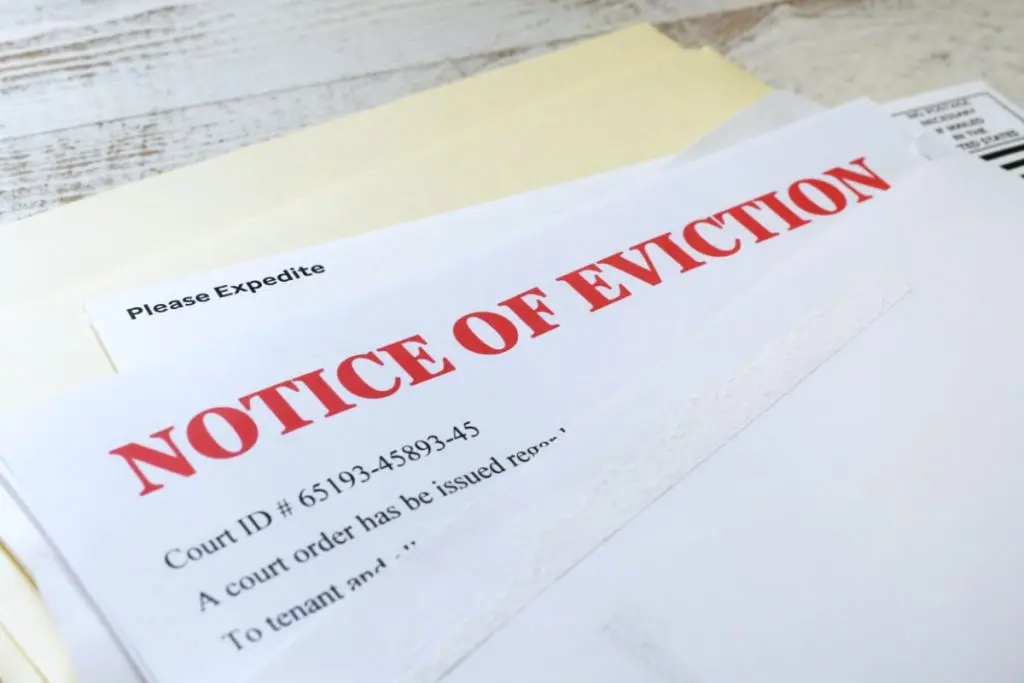Whether you’re a tenant facing the possibility of losing your home or a landlord trying to force out a tenant, there are eviction laws and eviction rights you should know.
In this guide, we’ll answer common questions like: What is eviction? How does an eviction work? And the steps both tenants and landlords need to take to protect their rights.
Disclaimer: This blog is meant to provide legal information and is for informational purposes only. It is not a substitute for professional legal advice.
KEY TAKEAWAYS
- Eviction happens when a landlord legally removes a tenant from a rental property.
- Both tenants and landlords have specific rights during the eviction process.
- Rent arrears and lease violations are common reasons for eviction.
What Is Eviction?
Eviction is a legal process that allows landlords to dislodge tenants from their apartments. This often happens when a tenant fails to pay rent, goes against the lease agreement, or engages in illegal or illicit activities such as selling hard drugs.

A landlord can’t force a tenant out without following the legal eviction process. If a landlord takes matters into their own hands by changing locks, cutting off utilities, or moving tenants out in other ways, they’re breaking the law and could face legal consequences.
The legal eviction requires proper setup to ensure landlord and tenant rights are respected.
Common Reasons for Eviction
Here are the common reasons why a landlord might choose to evict a tenant:
- Non-payment of rent: This is the predominant reason for eviction. If a tenant fails to pay rent on time, a landlord may have grounds to start eviction.
- Lease violations: Tenants are expected to follow the rules stated in their lease agreements. Possible violations like keeping pets in a no-pet apartment or having unauthorized occupants can lead to eviction.
- Property damage: If a tenant causes costly damages to the property, the landlord may issue an eviction notice.
- Illegal activities: Engaging in illegal activities on the property, such as drug use or illicit subletting, is critical enough to issue an immediate eviction notice.
- End of lease: The landlord may choose not to renew a tenant’s lease once it ends if they provide the proper notice.
Types of Eviction Processes
For a landlord seeking eviction, you can pursue two main possession orders: the standard possession order and the accelerated possession order. Let’s take a look at both:
Warrant for Possession
The standard possession order applies when a landlord is trying to recover unpaid rent or when the tenant violates the lease terms. Both landlord and tenant may have the chance to present their case during a court hearing. However, this process can take several weeks.
Accelerated Possession
This process is much faster and doesn’t involve a court hearing. Landlords can use this option if they’re not seeking unpaid rent and have given the tenant a valid notice. The accelerated possession process doesn’t pursue additional charges but focuses on quickly evicting the tenants.
The Eviction Process
The eviction doesn’t happen overnight, this process varies differently depending on the state in which you’re located. However, most eviction laws have a similar framework.
Here are the basic steps:
Notice to Quit
Before filing for eviction as a landlord they must issue a written notice to the tenant. This notice, commonly called an “eviction notice,” gives the tenant a set time to resolve the situation—move out, pay the rent, or desist from lease law violations.
Filing for Eviction
If the tenant doesn’t resolve the issue after the notice period, the landlord can file for a formal eviction lawsuit with the local court. For example, an eviction notice in Michigan requires the landlord to initiate the eviction case in the local district court where the property is located.
Court Hearing
The landlord and tenant can present their case in court. If the court sides with the landlord, the judge may issue a possession order. But if the tenant wins, the eviction process stops, allowing the tenant to stay in the home.
Eviction Enforcement
Once the possession order is granted, the landlord may need to involve local law enforcement to physically remove the tenant if they haven’t vacated by the specified date.
What to Do if You Are in Rent Arrears
If the tenant is falling behind on rent, here’s a better way to manage this situation:
- Communicate with the landlord: Open communication can often prevent residential eviction. Speak with the landlord to work out a payment plan.
- Seek financial assistance: If the tenant’s financial situation is dire, they may seek help from the local rental assistance programs or charity programs.
- Consider mediation: In some areas, mediation services help tenants and landlords establish a common ground to avoid eviction.
- Consider financial planning: A well-structured individual or family financial plan can help prevent future rent arrears. They can evaluate income and expenses, set financial goals, and create a budget that accounts for rent and other essential costs.
Tenant Rights During Eviction
Even if facing eviction, tenants have certain rights that protect them from unfair treatment. These rights vary by state, but here are the general protections tenants can expect:
- Proper notice: A formal eviction notice that outlines the reasons for eviction and how the duration for resolving the issue—if applicable—must be handed to the tenant.
- Right to contest the eviction: Tenants have the right to contest the eviction in court. If the eviction is unjust, or if the landlord hasn’t followed proper legal procedures, the tenant should prepare enough evidence that supports your case to a judge.
- Protection from retaliation: In many states, it’s illegal for landlords to evict tenants intending to retaliate for reporting housing code violations or other legitimate complaints.
- Discrimination protections: Landlords, in most states, can’t evict you based on discrimination related to race, gender, religion, disability, national origin, or family status. Such actions violate the Fair Housing Act.
- Stay Until the Court Order: You must not leave your rental property until a court officially orders the eviction. If your landlord tries to remove you before this, they are breaking the law.
Landlord Responsibilities
While you, as a landlord, have the right to evict tenants under certain conditions, you must also obey specific legal responsibilities during the process:
- Provide timely notice: As a landlord, you must give tenants a written eviction notice with a reasonable duration to resolve the issue. The time required can vary by state but typically ranges from 3 to 30 days.
- File a legal eviction: If the tenant does not comply with the eviction notice, then file for eviction with the local court in that area.
- Handle tenant property with care: Landlords must follow local laws regarding how to handle abandoned properties. In California, tenants have a 15 to 18-day window to collect leftover properties. After this window, the landlord can dispose of or sell the remaining items.
- Respect tenant rights: Even during an eviction, landlords must respect the tenant’s privacy and not engage in harassment or intimidation. Violating these rights can result in legal repercussions.
Changes in Housing Benefit
Housing benefits can play a significant role in helping tenants cover rent costs. However, changes in these benefits can have a direct impact on both tenants and landlords.
Impact of Eviction on Housing Benefits
If you’re a tenant receiving housing benefits, getting evicted may affect your eligibility for certain programs. Some housing programs require you to be in good standing with your rental payments.
If you’re in rent arrears or facing eviction, you must notify your housing benefit provider quickly to discuss your options.

For landlords, you must understand that housing benefits may not cover all rental costs, and any changes in a tenant’s benefits could result in missed payments. Hence, always keep an open communication with tenants receiving housing benefits, this can help address potential issues on time.
How Housing Benefits Are Paid
In most cases, the housing benefits are paid to the tenants, who are responsible for paying rent to the landlord. However, in some cases, these payments can be made directly to the landlord if the tenant requests it or if the tenant is behind on rent.
After the Eviction
Once an eviction process is completed, here’s what to expect:
As a tenant, while an eviction won’t directly appear on your credit report, unpaid rent that led to your eviction can still harm you, especially when you still owe rent.
Landlords often send unpaid balances to collection companies, this debt may show up on your credit report, impacting your score, and restricting you from getting a new apartment until the bill is paid.
For landlords, the eviction process can quickly become expensive. Court fees typically range between $50 to $500, and if you need to involve a Sheriff to remove the tenant, that can add another $50 to $400.
On top of that, you might need to hire a locksmith and cover property turnover costs, which include repairs and repainting.All these expenses add up, making eviction a costly and time-consuming process for you.
FAQ
What if My Landlord Goes Bankrupt or the Property Is Repossessed?
In most cases, tenants have the right to stay in their rental property until their lease expires, even if the landlord goes bankrupt or the property is repossessed.
What if I Am Evicted and Leave Some of My Possessions Behind?
Landlords must follow local laws regarding abandoned property. In most states, landlords must store your items for a certain period before they can dispose of them.
Can I Pay Rent After the Eviction Notice?
Yes, in many cases, you can still pay rent after receiving an eviction notice. This may stop the eviction process or prevent it from appearing on your credit report. But act quickly. Talk to your landlord about catching up on rent on time.